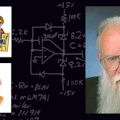On Old Olympus' Topmost Top, A Fat-Eared German Viewed A Hop.' Isn't it amazing? I read that back in '56 in Sinclair Lewis' Arrowsmith. That is a little rhyme to help medical students remember all the nerves in the head. I never learned all the nerves, but I think one of them was the Occipital nerve.
However, the little rhyme sure does work, because I have remembered it over 46 years. I bet a number of old doctors and medical students still remember that.
Tricks like that are often useful to remember other things. How come I remember ROY G BIV when it doesn't tell me the colour code of resistors? Ah – that is the sequence of colours in a prism or rainbow! I remembered the mnemonic even though I forgot what it's good for! For the resistors, many remember the old line, 'Big Boys Race Our Young Girls, But Violet Generally Wins'. Heck, I dunno. I never used that. I just learned all the colours. Red, red, brown is 220, and I learned all the rest of the colour-coded resistors, and I don't need any roygbiv to know that. If I ever saw a yellow, yellow, yellow resistor, I would immediately wonder why I never saw a 440-kΩ resistor before.
And several jokes have the punchline of 'Port is Left, Starboard is Right'. But all I need is to recall that there are more Rs in right than in left, and also more in starboard than in port.
What size is the density of air? How many ounces per cubic inch or foot? That's easy. (A) I wrote that down on page 64 of my pretty good book, How To Drive Into Accidents And How Not To, and (B) a stack of cubic feet of air (if you could do that at uniform sea-level density) that would stack up to 28,600 feet would weigh 144 X14.7 pounds. So the weight of the air is 14.7 X 144 per 28,600 cubic feet. And, of course, 29,027 feet is the height of Mount Everest, which is about 1.5% higher than that stack of 28,600 feet. Thus, the density of air is about 384 litres to weigh 1 pound, 1.19 grams/litre, or 0.074 pounds /cubic foot.
Everybody has their own ways to remember things that aren't obvious. Avogadro's Number (6.022 X1023), Boltzman's constant (1.38 X 10-23 in MKS units), and the charge on one electron (1.62 X10-19 coulombs) are old friends that I can't ever forget. Not to mention pi, which I can always remember to 14 decimal places, just in case I need it.
Trouble sleeping One time I was having trouble getting to sleep, so I decided to see what was the error in saying that log10 of 2 = 0.30103? So I started doing the math in my head. Hour after hour. I decided that if log of 2 = 0.30103 + k, then the log of 1024 must be 3.0103 + 10k, and log 1.024 must be 0.0103 + 10k. So how many times do I have to multiply 1.024 times itself to be equal to about 2? I never did get to sleep worth a darn. But I did convince myself, after about three sleepless nights, that k must be about -0.000000004. So the log of 2 is 0.301029996. In other words, (0.010300 + 10k) X about 29.227 is about 0.30103. I just computed 1.024 to about the 29.227 power, computing all the decimal places in my head. I did a lot of long multiplication in my head. But that's not mnemonic. That's just deriving it, from first principles. Still, I can now recall that the log of 2 does not end at '0.30103' but ends with '0.301029996 (to nine decimal places).'My seventh grade teacher once decided he had to 'punish' me for some imagined offence. So he forced me to remember the square roots of all the digits from 1 to 10. Okay, a couple of them are trivial. And I never find much use for the square root of 7. But the 1.414, 2.236, and 2.828 are loyal and useful friends. What useful mnemonics do you guys use?
Comments invited!
[email protected]
or: Mail Stop D2597A, National Semiconductor
PO Box 58090, Santa Clara, CA 95052-8090.
About the Author

Bob Pease
Bob obtained a BSEE from MIT in 1961 and was a staff scientist at National Semiconductor Corp., Santa Clara, CA, for many years. He was a well known and long time contributing editor to Electronic Design.
We also have a number of PDF eBooks by Bob that members can download from the Electronic Design Members Library.